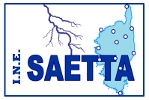SAETTA
Suivi de l’Activité Electrique Tridimensionnelle Totale de l’Atmosphère
SAETTA (Suivi de l’Activité Electrique Tridimensionnelle Totale de l’Atmosphère) detects and localizes in three dimensions the electromagnetic radiation emitted by atmospheric discharges in the VHF 60-66 MHz band. It provides a unique mapping of lightning and electrical activity within thunderstorms within a 300 km radius of central Corsica. Its observations are used to study electrical activity and its links with the dynamic and microphysical processes at work within thunderstorms. They are also used to validate space and ground-based detectors, and to exploit their observations synergistically to gain a better understanding of the physical processes behind lightning.
The SAETTA network is supported by CNRS-INSU, CNES and OMP via its Instrument National d’Excellence (INE) label, and by the Corsican regional authorities via the CORSiCA project.
DESCRIPTION
Lightning emits not only light and sound, but also broad-spectrum electromagnetic radiation. The characteristics of this electromagnetic radiation vary according to the components that make up the flash. Radiation emitted in the VHF range exists during the three phases of a lightning flash: the tracer phase, the active phase and the junction phase. This VHF radiation is associated with air ionization processes involving negative and positive tracers. Negative tracers by their very nature emit VHF radiation of greater amplitude, and are mainly localized by SAETTA due to their pulsed emission.
SAETTA measurement principle
Among the various lightning localization techniques, the time-of-arrival difference method consists in matching impulse phenomena detected by at least 4 distant detectors. These detections are carried out at high temporal resolution (~40 ns) with high time-stamping accuracy. Each pulse is then positioned at the intersection of hyperboloidal planes, each of which contains the potential location of this pulse for a pair of detectors. For SAETTA, a minimum of six stations is required to locate each pulse in 4 dimensions (time, latitude, longitude, altitude).
Description of a SAETTA station
The SAETTA instrument is composed of 12 stations deployed in Corsica. Each station consists of a VHF antenna (lightning detection), a GPS receiver (precise dating of events), a telecommunications antenna (station tracking and real-time data broadcasting), an electronic box for detection, discrimination, on-site storage and real-time transfer of recordings, and power supply (solar panel and batteries). Each SAETTA station records the electromagnetic signal and stores certain characteristics on local storage disks, but transmits degraded data via mobile telephony, sufficient to monitor electrical activity in Corsica and the surrounding region in real time.
How the SAETTA network works
SAETTA operates in two modes: real-time and delayed-time. Data collected in real time by SAETTA’s 12 stations are transmitted via the Internet to a dedicated server at the Laboratoire d’Aérologie (Toulouse), from where the positions of electrical discharges are calculated with a delay of 3 minutes. Delayed-time mode calculates electrical discharge positions from data stored at each station and retrieved after each maintenance visit. This delayed-time data is used for scientific analysis.
An example of intra-cloud lightning
Figure 1 shows the temporal evolution of the amplitude of the VHF signal detected by the 12 SAETTA stations over a period of approximately 1.4 seconds. These different signals show the almost temporal continuity of the signal emitted by the lightning. It should be noted that acquisition thresholds specific to each station and the ambient electromagnetic noise explain the different minimum power values measured at each station.

Figure 2 shows the lightning flash that was reconstructed from the signals detected by the 12 stations and presented in Figure 1. This flash is a so-called intra-cloud flash located on the eastern side of Corsica. Lasting 1.4 seconds, it was triggered at an altitude of 11 km, its negative tracer propagating in the upper part of the cloud between 10 and 12 km away from the triggering point over a distance of more than 30 km. Its positive tracer, on the other hand, first spread downwards from the trigger zone, then extended horizontally at an altitude of 5 km to a distance of 20 km.


